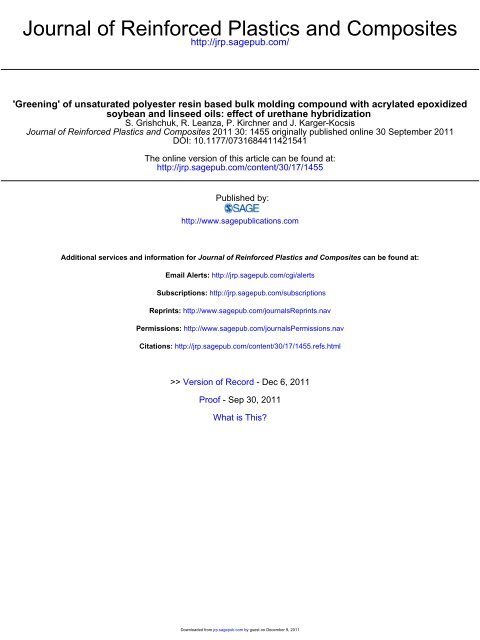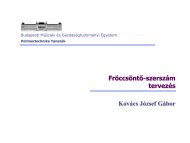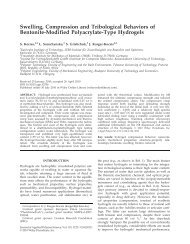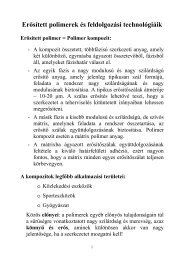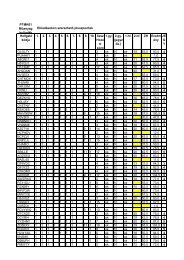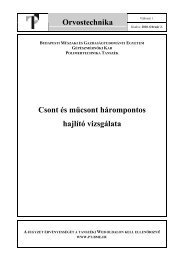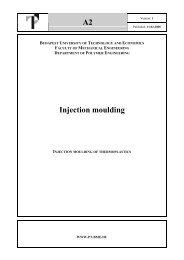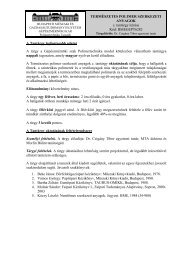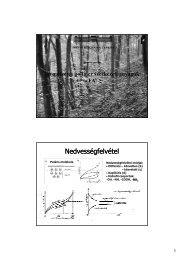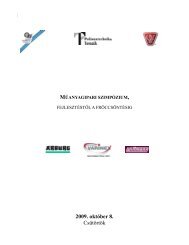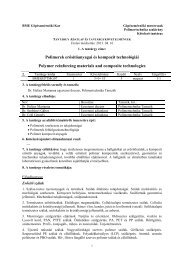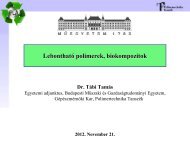Journal of Reinforced Plastics and Composites
Journal of Reinforced Plastics and Composites
Journal of Reinforced Plastics and Composites
You also want an ePaper? Increase the reach of your titles
YUMPU automatically turns print PDFs into web optimized ePapers that Google loves.
<strong>Journal</strong> <strong>of</strong> <strong>Reinforced</strong> <strong>Plastics</strong> <strong>and</strong> <strong>Composites</strong>http://jrp.sagepub.com/'Greening' <strong>of</strong> unsaturated polyester resin based bulk molding compound with acrylated epoxidizedsoybean <strong>and</strong> linseed oils: effect <strong>of</strong> urethane hybridizationS. Grishchuk, R. Leanza, P. Kirchner <strong>and</strong> J. Karger-Kocsis<strong>Journal</strong> <strong>of</strong> <strong>Reinforced</strong> <strong>Plastics</strong> <strong>and</strong> <strong>Composites</strong> 2011 30: 1455 originally published online 30 September 2011DOI: 10.1177/0731684411421541The online version <strong>of</strong> this article can be found at:http://jrp.sagepub.com/content/30/17/1455Published by:http://www.sagepublications.comAdditional services <strong>and</strong> information for <strong>Journal</strong> <strong>of</strong> <strong>Reinforced</strong> <strong>Plastics</strong> <strong>and</strong> <strong>Composites</strong> can be found at:Email Alerts: http://jrp.sagepub.com/cgi/alertsSubscriptions: http://jrp.sagepub.com/subscriptionsReprints: http://www.sagepub.com/journalsReprints.navPermissions: http://www.sagepub.com/journalsPermissions.navCitations: http://jrp.sagepub.com/content/30/17/1455.refs.html>> Version <strong>of</strong> Record - Dec 6, 2011Pro<strong>of</strong> - Sep 30, 2011What is This?Downloaded from jrp.sagepub.com by guest on December 9, 2011
Grishchuk et al. 1457Differences in the unsaturations <strong>of</strong> the soybean <strong>and</strong>linseed oils (different contents <strong>of</strong> unsaturated linoleic,linolenic, oleic <strong>and</strong> saturated palmitic, <strong>and</strong> stearic fattyacid derivatives in the structure <strong>of</strong> respective triglycerides)used result in different epoxidation degrees.In addition, different acrylation levels are realized inthe oils used in this study. Note that AESO <strong>and</strong>AELO were acrylated up to higher degrees comparedto EASO – cf. Table 1. As network modifier, a PMDI(isoPMDI 92150 <strong>of</strong> BASF Group, Elastogran GmbH,Lemfo¨rde, Germany) served in this study.Specimen preparationThe oils were incorporated in 5, 10, <strong>and</strong> 15 wt% (withrespect to the base resin) in the parent BMC by mixingin a laboratory Brabender Plastograph (Du¨sseldorf,Germany) kneader equipped with a 50 cm 3 mixingchamber. Kneading occurred at 100 rpm at ambienttemperature for 7 min. PMDI was introduced in theBMC, diluted by the vegetable oils used, also by kneadingin the Brabender chamber. Throughout this article,the following coding is used: BMC resin type (UP) indicatingurethane hybridization (UH) <strong>and</strong> PMDI amountin the latter case (UPUH1, 2 or 3) – plant oil abbreviation(according to Table 1) with its amount. ThreePMDI/UP (without styrene) weight ratios, namely0.6 : 1 (UPUH1), 0.65 : 1 (UPUH2), <strong>and</strong> 0.7 : 1(UPUH3) were used for the preparation <strong>of</strong> hybridBMCs. So, BMC UP–AELO-5% means a BMC containing5 wt% AELO (with respect to the base resincontaining both UP <strong>and</strong> styrene), whereas BMCUPUH3–AESO-5% a PMDI hybridized version containingthe highest amount <strong>of</strong> PMDI (PMDI/UPweight ratio ¼ 0.7 : 1) diluted with 5 wt% AESO withrespect to the base resin. Note that the UH conceptwas adapted only for BMCs with 5 wt% functionalizedplant oil. For sake <strong>of</strong> a better overlook, the above designationsare summarized in Table 2.Plaques (160 100 mm 2 )<strong>of</strong>ca 4 mm thickness wereproduced by hot pressing at T ¼ 170 C for 5 min using160 kN load. These conditions were selected based ondifferential scanning calorimetric tests performed onthe BMC. Specimens from the plaques were cut bysawing.TestingThe thermo-mechanical performance <strong>of</strong> the BMCswas studied by dynamic-mechanical thermal analysis(DMTA). DMTA traces (storage modulus, E 0 ; <strong>and</strong>the mechanical loss factor, tan vs. temperature) weredetermined on rectangular specimens (60 8 4mm 3 ;length width thickness) by DMA Q800 <strong>of</strong> TAInstruments (New Castle, DE, USA) in flexural modeat 10 Hz frequency. Tests were performed under displacementcontrol (15 mm amplitude) using sinusoidaloscillation under dynamic conditions in the temperaturerange 100 C to +300 C at a heating rate <strong>of</strong>1 C/min.The static fracture toughness (K c ) <strong>and</strong> fractureenergy (G c ) were determined on the compact tensionTable 1. Basic characteristics <strong>of</strong> the functionalized plant oils usedOil Viscosity at 25 C (Pas) Acid value (mg (KOH)/g) Epoxy value (mg (KOH)/g) Density at 25 C (g/mL)EASO 29.1 8.1 8.5 1.04AESO 26.0 15.1 1.8 1.03AELO 29.7 17.3 1.2 1.04Table 2. Designations <strong>of</strong> the BMCs producedDesignationBMC UP-RefBMC UP–EASO(AESO, AELO)-5(10,15)%BMC UPUH1(2,3)-RefBMC UPUH1(2,3)–EASO 5%CompositionParent UP-based BMCBMC UP compounds with different plant oils, namely EASO,AESO, <strong>and</strong> AELO. The content <strong>of</strong> the latter with respectto the UP resin is given in wt% (5, 10, or 15)BMC UP compounds modified by PMDI. The PMDI/UPratios are 0.6:1, 0.65:1, <strong>and</strong> 0.7:1 (if it was already 1, then consideronly : in 0.7:1!) for the systems markedby 1, 2, <strong>and</strong> 3, respectivelyBMC UP compounds containing both PMDI <strong>and</strong> EASO.The PMDI/UP ratio varies for the systems denoted by 1, 2, <strong>and</strong> 3as indicated above, whereas the EASO content is constant (5 wt%)Downloaded from jrp.sagepub.com by guest on December 9, 2011
1458 <strong>Journal</strong> <strong>of</strong> <strong>Reinforced</strong> <strong>Plastics</strong> <strong>and</strong> <strong>Composites</strong> 30(17)(CT) specimens (dimensions: 35 35 3 (thickness)mm 3 ). The CT specimens were cut from the plaques,notched by sawing <strong>and</strong> the notch root sharpened byrazor blade tapping prior to testing on a Zwick 1445machine (Zwick, Ulm, Germany) at room temperature(RT) with velocity <strong>of</strong> 1 mm/min crosshead speed. K c <strong>and</strong>G c were computed in accordance with the ISO 13586-1st<strong>and</strong>ard. The fracture surface <strong>of</strong> the CT specimens wasinspected in a scanning electron microscope (SEM;JSM-5400 <strong>of</strong> Jeol, Tokyo, Japan). Prior to SEM, thefracture surfaces were sputtered with a platinum/palladiumalloy to create a conductive cover layer.The dynamic impact properties were characterized bythe Charpy impact strength, measured on unnotched specimensaccording to ISO 179/1. The specimens (80 10 4mm 3 –length width thickness, span length 62 mm)were subjected to high-speed (3 m/s) impact bending atRT on an instrumented pendulum <strong>of</strong> Ceast (Pianezza,Italy). The energy <strong>of</strong> the hammer used was 4 J.The resins were subjected to thermogravimetric analysis(TGA) in a DTG-60 device <strong>of</strong> Shimadzu (Columbia,MD, USA). The TGA experiments were conductedunder nitrogen atmosphere in the temperature range25 C to +900 C with a heating rate 10 C/min.Results <strong>and</strong> discussionDMTA behaviorFigures 2 <strong>and</strong> 3 show the E 0 vs. T <strong>and</strong> tan vs. T tracesfor the UP-based BMC at 5 wt% (with respect to thebase resin) functionalized plant oil type, <strong>and</strong> as afunction <strong>of</strong> EASO content, respectively. The DMTAresults covering the E 0 modulus at RT, T g (based onthe a-peak position in the tan vs. T trace), <strong>and</strong> intensity<strong>of</strong> the latter are tabulated in Table 3. One canrecognize that the incorporation <strong>of</strong> 5 wt% functionalizedplant oil in the co-reactive matrix markedlyreduced the stiffness (E 0 modulus) <strong>of</strong> the BMCs. Theoil type affected the stiffness in the glassy state, moreexactly the E 0 modulus below the temperature range50–60 C. The latter temperature is closely matchedwith that <strong>of</strong> the T g <strong>of</strong> the styrene cross-linked acrylatedepoxidized plant oils. 12 It is also found that the E 0modulus drop follows the ranking: Ref > EASO >AESO > AELO. This ranking, accompanied withsome increase in the T g values, is in line with the initialamount <strong>of</strong> co-reactive acrylic groups in the related oils(cf. Table 1). Moreover, one can get the impression thatchemical incorporation <strong>of</strong> functionalized oils in the networkstructure in higher amounts has a stronger impacton the stiffness <strong>of</strong> the resulting BMCs in the glassy statethan just physical plasticization. Incorporation <strong>of</strong> theplant oils affected both the broadening <strong>and</strong> intensity <strong>of</strong>the alpha-relaxation peak. Enhanced broadening <strong>and</strong>intensity suggest that a wider range <strong>of</strong> segmental unitstakes part in the alpha-relaxation process <strong>of</strong> a moreirregular networks compared to the reference one.This is linked with different amounts <strong>of</strong> partiallyreacted molecular fragments within the networksformed in the presence <strong>of</strong> oils <strong>of</strong> different functionalities.The shoulder in the temperature range <strong>of</strong> 60 Cislinked with the homo- <strong>and</strong> copolymerization reactions(with both styrene <strong>and</strong> UP) <strong>of</strong> the related plant oils.Figure 2. Storage modulus (E 0 ) <strong>and</strong> mechanical loss factor (tan ) as a function <strong>of</strong> temperature for BMCs modified in 5 wt% withdifferent functionalized plant oils. Note: Numbering follows the legends from the top to the bottom.Downloaded from jrp.sagepub.com by guest on December 9, 2011
Grishchuk et al. 1459Figure 3. Storage modulus (E 0 ) <strong>and</strong> mechanical loss factor (tan ) as a function <strong>of</strong> temperature for BMCs modified with varyingamount <strong>of</strong> EASO. Note: Numbering follows the legends from the top to the bottom.Table 3. Dynamic mechanical, fracture mechanical, <strong>and</strong> impact properties <strong>of</strong> modified UP-based BMCsDesignationT g ( C)E 0 (GPa) E 0 (GPa)25 C T g +50 C Shoulder T g1 T g2K c (MPam 1/2 ) G c (kJm 2 ) a K (kJ/m 2 )BMC UP-Ref 18.7 4.7 75 180 – 3.97 0.23 2.40 0.22 3.54 0.51BMC UP–AELO 5% 13.8 3.0 70 175 – 3.40 0.24 1.99 0.24 4.22 0.43BMC UP–AESO 5% 14.7 3.0 70 172 – 3.69 0.33 2.23 0.35 2.68 0.26BMC UP–EASO 5% 16.0 3.2 70 169 – 4.13 0.25 2.72 0.33 3.58 0.44BMC UP–EASO 10% 14.6 3.8 75 158 – 4.41 0.41 2.57 1.00 1.60 0.18BMC UP–EASO 15% 9.9 2.3 70 175 – 3.72 0.26 2.18 0.22 1.38 0.16BMC UPUH1–EASO 5% 12.9 2.1 73 209 235 3.77 0.59 2.57 0.46 3.86 0.57BMC UPUH2–EASO 5% 11.2 1.6 83 – 234 3.89 0.14 2.36 0.29 4.74 0.90BMC UPUH3–EASO 5% 12.1 1.1 73 215 242 4.11 0.43 2.29 0.18 4.97 0.50BMC UPUH2-Ref 11.1 1.9 90 – 237 3.51 0.13 1.74 0.18 5.34 0.49This is quite a complex reaction pathway as discussedrecently. 4,13 The beta-relaxation, caused by the motions<strong>of</strong> the phenyl rings around the methylene links 14 peakedat a temperature <strong>of</strong> 90 C, increased slightly by the oilmodification. Above the temperature range 50–60 C,the stiffness <strong>of</strong> the BMCs was similar <strong>and</strong> independent<strong>of</strong> the plant oils used. The E 0 vs. T traces run, however,further well below that <strong>of</strong> the reference BMC. Theseobservations confirm that the oils acted as a reactiveplasticizer for the UP resin, lowering its cross-link density.On the other h<strong>and</strong>, strong reduction in the stiffness<strong>of</strong> the modified BMCs in glassy state is probably causedby a change in the matrix/filler interactions. In theopinion <strong>of</strong> the authors, the matrix adhesion to GF<strong>and</strong> kaolin is negatively influenced by the incorporation<strong>of</strong> the functional plant oils used.Based on the DMTA spectra in Figure 3, one canestablish that with increasing dilution <strong>of</strong> the parent UPresin by EASO, the stiffness <strong>of</strong> the BMC graduallydecreases. This was accompanied with the broadening<strong>of</strong> the alpha-relaxation peak <strong>and</strong> with its shiftingtoward lower temperatures. Further stiffness reductionwas observed by increasing the amount <strong>of</strong> EASO (atleast in the glassy state). Unexpectedly, BMC containing10 wt% EASO (with respect to the base resin)showed a higher E 0 compared to other EASO containinghybrids in the viscoelastic state. In combinationwith lower intensity <strong>of</strong> the main relaxation peakDownloaded from jrp.sagepub.com by guest on December 9, 2011
1460 <strong>Journal</strong> <strong>of</strong> <strong>Reinforced</strong> <strong>Plastics</strong> <strong>and</strong> <strong>Composites</strong> 30(17)compared to other systems, this fact suggests that amore regular network structure is realized in this case.By contrast, higher intensities <strong>of</strong> the T g peaks comparedto BMC UP-Ref are the characteristic forBMCs containing 5 <strong>and</strong> 15 wt% <strong>of</strong> EASO, indicatingthe development <strong>of</strong> less regular networks. A possiblereason behind this observation is the occurrence <strong>of</strong>chemical reactions between the residual groups (epoxy<strong>and</strong> hydroxyl) <strong>of</strong> EASO <strong>and</strong> co-reacting groups (carboxyl<strong>and</strong> hydroxyl) <strong>of</strong> UP resin, superimposed tothe free radical induced co-polymerization reactions.Recall that all these reactions strongly influence theformation <strong>of</strong> the final network. Despite strong plasticizationeffect, the system containing 15 wt% <strong>of</strong> EASOshowed the highest T g value compared to those <strong>of</strong> otherEASO containing BMCs. This underlines again howcomplex the chemical pathway <strong>and</strong> final network structuremay be, if multifunctional co-reactants, such asEASO, are used in UP-based BMC formulations.Interesting results were obtained by hybridization <strong>of</strong>BMCs with PMDI (BMC UP–EASO 5% was selectedfor this purpose). Strong increase in T g was observedfor hybrids compared to both reference <strong>and</strong> EASOcontainingBMCs (Figure 4, Table 3). This indicatesthat PMDI is an effective ‘hybridizer’ for UP-basedBMC formulations. However, a drastic reduction <strong>of</strong>the stiffness was observed in this case. This is probablydue to strong dilution (lower filler content) <strong>and</strong> selectiveabsorption <strong>of</strong> reaction products on the filler surfacecaused by the incorporation <strong>of</strong> PMDI whose amountis comparable with that <strong>of</strong> the UP resin. It is surmisedthat the reaction <strong>of</strong> PMDI with the water content <strong>of</strong>kaolin (>10%) is that key factor which negatively influencesthe final properties <strong>of</strong> related hybrids. The kaolin,covered by a s<strong>of</strong>t interphase layer, is likely losing itsfiller activity. To prove this argument, it is, however,necessary to work with BMCs which do not containkaolin or other fillers with crystal water.For the example <strong>of</strong> UPUH2-based systems, it wasshown that 5 wt% EASO has only marginal effect onthe stiffness <strong>of</strong> hybrid BMC (cf. Figure 4). This wasaccompanied with some reduction <strong>of</strong> T g as well aswith a broadening <strong>of</strong> the alpha-relaxation peak <strong>and</strong>with its shift toward lower temperatures. Some increase<strong>of</strong> the intensity <strong>of</strong> T g peak <strong>and</strong> no significant influenceon the beta-relaxation were also detected in this case.Some differences were detected for the UPUH systemscontaining lower (BMC UPUH1–EASO 5%)<strong>and</strong> higher amount <strong>of</strong> PMDI (BMC UPUH3–EASO5%) compared to BMC UPUH2–EASO 5% (cf.Figure 5). The stiffness <strong>of</strong> the former systems is higherthan that for BMC UPUH2–EASO 5% practically inthe whole investigated temperature range. Moreover,the alpha-relaxation (with double-peak) exhibitedlower intensity for BMC UPUH1–EASO 5% <strong>and</strong>BMC UPUH3–EASO 5% systems compared to that <strong>of</strong>BMC UPUH2– EASO 5% <strong>and</strong> BMC UPUH-Ref. Thisindicates that a more regular, but still heterogeneousnetwork structure was formed in BMC UPUH2–EASO 5% <strong>and</strong> BMC UPUH2-Ref. Probably, notonly dilution phenomena, but also the ratio between –NCO <strong>and</strong> other co-reacting groups influenced the finalFigure 4. Influence <strong>of</strong> hybridization with PMDI on the storage modulus (E 0 ) <strong>and</strong> mechanical loss factor (tan ) as a function <strong>of</strong>temperature for BMC UP-Ref <strong>and</strong> BMC UP–EASO 5%. Note: Numbering follows the legends from the top to the bottom.Downloaded from jrp.sagepub.com by guest on December 9, 2011
Grishchuk et al. 1461viscoelastic properties <strong>of</strong> the BMC hybrids. At the sametime, the highest amount <strong>of</strong> PMDI yielded the highestT g value for BMC UPUH3–EASO 5% compared tothe other hybrids including the reference compound (cf.Table 3 <strong>and</strong> Figure 5).Static fracture mechanics <strong>and</strong> related failureThe fracture toughness (K c ) <strong>and</strong> energy data (G c ) aresummarized in Table 3. Based on the related data <strong>and</strong>considering their scatter range, the following trends canbe deduced:. At 5 wt% oil modification, EASO yielded someimprovement in both the K c <strong>and</strong> G c data in contrastto AESO <strong>and</strong> AELO.. There was practically no change in both the K c <strong>and</strong>G c data with increasing EASO content.. PMDI incorporation (UPUH2-Ref) reduced thefracture mechanical parameters compared to theunmodified UP (UP-Ref). With increasing PMDIamount at 5 wt% EASO content K c <strong>and</strong> G c slightlyincreased <strong>and</strong> decreased, respectively. This – in linewith the expectation – suggests that increasing crosslinkdensity enhanced the stiffness, however, at cost<strong>of</strong> the toughness. It is worthy to note that the G cvalue <strong>of</strong> the UPUH–EASO hybrids was higher thatthat <strong>of</strong> UPUH2-Ref.As the K c <strong>and</strong> G c data <strong>of</strong> the BMC samples wereonly marginally affected by the oil modification, nochange was expected in respect to their failure modes.This was the case, in fact, as shown in Figure 6. Therelated SEM pictures give explanation for the scatterin the K c <strong>and</strong> G c data (cf. Table 3). Note that theorientation <strong>of</strong> the short GFs with respect to the notchingdirection (i.e., final crack plane) is crucial: the moreGF are aligned in the loading <strong>and</strong> thus transverse to thenotch direction, the higher the fracture mechanicalparameters are. 15The effect <strong>of</strong> PMDI is highlighted in Figure 7.Comparing the fracture surfaces <strong>of</strong> the referenceBMC without <strong>and</strong> with PMDI, one can notice thatPMDI reduced the matrix micro-cracking <strong>and</strong> contributedto a better GF/matrix adhesion. The latterstrongly affected the pull-out <strong>of</strong> GF. The overalleffect <strong>of</strong> this change was, however, quite small on thefracture mechanical parameters – at least under quasistaticloading conditions.Dynamic impact behavior <strong>and</strong> related failureThe unnotched Charpy impact strength values are alsolisted in Table 3 for the BMCs investigated. At 5 wt%oil content, AELO slightly improved <strong>and</strong> EASO didnot affect, while AESO slightly reduced the impactstrength. This means that characteristics <strong>of</strong> the functionalizedplant oils may affect the dynamic impactbehavior <strong>of</strong> BMCs. The related change can hardly betraced to some alteration in the failure mode, as demonstratedin Figure 8. Note that the basic characteristics<strong>of</strong> the fractures surfaces are identical.Figure 5. Storage modulus (E 0 ) <strong>and</strong> mechanical loss factor (tan ) as a function <strong>of</strong> temperature for selected BMCs hybridized withdifferent amounts <strong>of</strong> PMDI. Note: Numbering follows the legends from the top to the bottom.Downloaded from jrp.sagepub.com by guest on December 9, 2011
1462 <strong>Journal</strong> <strong>of</strong> <strong>Reinforced</strong> <strong>Plastics</strong> <strong>and</strong> <strong>Composites</strong> 30(17)Figure 6. SEM pictures taken from the fracture surfaces <strong>of</strong> the CT-specimens cut <strong>of</strong> the unmodified (a) <strong>and</strong> with 15 wt% EASOmodified(b) BMCs.Figure 7. SEM pictures taken from the fracture surfaces <strong>of</strong> the CT specimens cut <strong>of</strong> the unmodified (a) <strong>and</strong> with PMDI-modified(PMDI/UP ratio ¼ 0.65/1) BMCs (b).With increasing EASO content, the Charpy impactstrength dropped to more than the half <strong>of</strong> the BMCreference value. On the other h<strong>and</strong>, the differencebetween the related data <strong>of</strong> BMC with 10 <strong>and</strong> 15 wt%oil contents was negligible. The observed change in theCharpy data suggests that the actual amount <strong>of</strong> filler<strong>and</strong> reinforcement controls the Charpy impact response<strong>of</strong> BMCs. Adding PMDI resulted in a prominentincrease in the unnotched Charpy impact strength <strong>of</strong>the reference BMC. The SEM pictures in Figure 9 evidencethat PMDI incorporation improved the matrix/GF adhesion. This is well reflected in reduced GFpull-out length <strong>and</strong> in the appearance <strong>of</strong> sheathedGF surface – compare SEM pictures at the samemagnification in Figures 8 <strong>and</strong> 9. Further, PMDI‘compacted’ the filled matrix which became less pronefor multiple matrix cracking. The latter is, however, anefficient energy absorbing mechanism. Apparently, thefiber-related events (fracture <strong>and</strong> pull-out) owing to theimproved GF/matrix adhesion compensated thismatrix-related change. The combined action <strong>of</strong> EASO<strong>and</strong> PMDI was comparable with that <strong>of</strong> the PMDIalone – cf. Table 3.It is worthy to note that the effect <strong>of</strong> PMDI underdynamic loading is far more pronounced than in thefracture mechanical tests under static loading. It isdue to the fact that the matrix- (brittle cracking inour case) <strong>and</strong> fiber-related failure (fracture, pull-out,Downloaded from jrp.sagepub.com by guest on December 9, 2011
Grishchuk et al. 1463Figure 8. SEM pictures taken from the fracture surfaces <strong>of</strong> Charpy specimens cut <strong>of</strong> the unmodified (a) <strong>and</strong> with 5 wt% EASOmodifiedBMC (b).Figure 9. SEM pictures taken from the fracture surfaces <strong>of</strong> Charpy specimens cut <strong>of</strong> the PMDI-modified BMC without (a <strong>and</strong> b) <strong>and</strong>with 5 wt% EASO (c <strong>and</strong> d).Downloaded from jrp.sagepub.com by guest on December 9, 2011
1464 <strong>Journal</strong> <strong>of</strong> <strong>Reinforced</strong> <strong>Plastics</strong> <strong>and</strong> <strong>Composites</strong> 30(17)debonding) events, including their relative frequency,which control the fracture behavior, strongly dependon the loading conditions (static, dynamic). 16Thermogravimetric behaviorThe TGA curves <strong>of</strong> the BMCs investigated areshown in Figures 10 <strong>and</strong> 11. Find that their thermaldegradation occurred in two steps. The first step witha maximum degradation rate at 320 C <strong>and</strong> yielding aweight loss <strong>of</strong> ca 25 wt% represents the degradation <strong>of</strong>the UP matrix. This value is in line with the information<strong>of</strong> the BMC producer (see above) <strong>and</strong> supportedalso by TGA results achieved on UP <strong>and</strong> BMCsystems. 17 Further, plant oil modification affectedonly this degradation step (cf. Figures 10 <strong>and</strong> 11).Figure 10. TGA curves <strong>of</strong> BMCs modified with different plant oils in 5 wt% amount. Note: Numbering follows the legends from thetop to the bottom.Figure 11. TGA curves <strong>of</strong> BMCs modified with different EASO amounts. Note: Numbering follows the legends from the top to thebottom.Downloaded from jrp.sagepub.com by guest on December 9, 2011
Grishchuk et al. 1465Figure 12. TGA curves <strong>of</strong> BMCs containing 5 wt% EASO in absence <strong>and</strong> presence <strong>of</strong> various amounts <strong>of</strong> PMDI (PMDI/UP (withoutstyrene) weight ratios <strong>of</strong> 0.6:1 – UPUH1, 0.65:1 – UPUH2, <strong>and</strong> 0.7:1 – UPUH3). Note: Numbering follows the legends from the top tothe bottom.With increasing EASO content, the weight loss <strong>of</strong> theBMCs increased accordingly. The second step showingan inflexion point at a temperature <strong>of</strong> 750 C reflects thedecompositions <strong>of</strong> carbonate minerals, used as fillers, in theBMC. Assuming that this filler is solely CaCO 3 , theamount <strong>of</strong> the latter in the BMC recipe can be estimatedfor 20 wt%. Based on this estimate, the kaolin contentmay be at 36 wt%. The residue at T ¼ 900 Cisintherange 53–55 wt%, which is well matched with the totalamount <strong>of</strong> GF <strong>and</strong> kaolin in the parent BMC formulation.Hybridization <strong>of</strong> BMCs with PMDI resulted inslightly improved thermal stability (Figure 12).However, onset <strong>of</strong> the degradation occurred somewhatearlier in the temperature scale. For the example <strong>of</strong>BMC UPUH2 system, it was also shown that incorporation<strong>of</strong> 5 wt% EASO (with respect to the base UPresin solution) enhanced the first degradation step. Onthe other h<strong>and</strong>, thermal stability <strong>of</strong> the hybrid BMCs isnot influenced by increasing the amount <strong>of</strong> PMDI. Thefinal residue at 900 C <strong>of</strong> UPUH-type BMCs was onlyslightly reduced compared to that <strong>of</strong> UP BMC-Ref,despite obvious dilution <strong>of</strong> the formulations by PMDI.ConclusionThis article was dedicated to check the effects <strong>of</strong> dilution<strong>of</strong> UP resin based BMCs with acrylated zepoxidizedsoybean <strong>and</strong> linseed oils. These functionalizedoils were added up to 15 wt% in the parent BMC.In addition, PMDI was used as further modifier.Modification with the plant oils was associated with astrong reduction <strong>of</strong> the stiffness (E-modulus) <strong>of</strong> theBMCs in the glassy state. An even larger drop in theE-modulus was noticed for the BMC after polyisocyanatemodification. The latter was traced to a reaction<strong>of</strong> –NCO with the crystal water <strong>of</strong> kaolin, present asmajor filler – apart from chalk <strong>and</strong> GF – in the BMCrecipe. On the other h<strong>and</strong>, the glass transition temperature<strong>of</strong> the compounds was markedly enhanced via the‘urethane route’. The static fracture mechanical parametersdid not change prominently with the modification(plant oil type <strong>and</strong> amount <strong>and</strong> addition <strong>of</strong> polyisocyanate).The Charpy impact strength proved to be moresensitive to the above modifications than the static fracturemechanical parameters. This was explained bydifferences in the occurrence <strong>of</strong> the fiber- <strong>and</strong> matrixrelatedindividual failure events affected by the plantoils, <strong>and</strong> especially by the further addition <strong>of</strong> polyisocyanate.The thermal degradation behavior <strong>of</strong> themodified BMCs did not change pr<strong>of</strong>oundly as a function<strong>of</strong> the modification performed. The results suggestthat the BMC recipe should be adjusted when the‘greening’ <strong>of</strong> BMC via matrix modification with functionalizedplant oils is the target. ‘Adjustment’ meansrecipe modifications to compensate the loss in theperformance <strong>of</strong> BMCs owing to the introduction <strong>of</strong>functionalized plant oils. In this respect, the hybridizationwith PMDI seems to be quite promising, providedthe formulation does not contain hydrated fillers.FundingThis research was performed in the framework <strong>of</strong> a bilateralcooperation program between Germany (DAAD) <strong>and</strong>Hungary (MO¨ B) which is gratefully acknowledged.Downloaded from jrp.sagepub.com by guest on December 9, 2011
1466 <strong>Journal</strong> <strong>of</strong> <strong>Reinforced</strong> <strong>Plastics</strong> <strong>and</strong> <strong>Composites</strong> 30(17)References1. Gum WF, Riese W <strong>and</strong> Ulrich H (eds). Reaction polymers.Munich: Hanser, 1992.2. Neitzel M <strong>and</strong> Mitschang P (eds). H<strong>and</strong>buchVerbundwerkst<strong>of</strong>fe. Munich: Hanser, 2004.3. Li F <strong>and</strong> Larock RC. New soybean oil-divinylbenzenethermosetting copolymers. II. Dynamic mechanical properties.J Appl Polym Sci 2000; 38: 2721–2738.4. Grishchuk S <strong>and</strong> Karger-Kocsis J. Hybrid thermosetsfrom vinyl ester resin <strong>and</strong> acrylated epoxidized soybeanoil (AESO). Express Polym Lett 2011; 5: 2–11.5. Lu J, Khot S <strong>and</strong> Wool RP. New sheet molding compoundresins from soybean oil. I. Synthesis <strong>and</strong> characterization.Polymer 2005; 46: 71–80.6. Lu J <strong>and</strong> Wool RP. Novel thermosetting resins for SMCapplications from linseed oil: synthesis, characterization,<strong>and</strong> properties. J Appl Polym Sci 2006; 99: 2481–2488.7. Mehta G, Mohanty AK, Thayer K, Misra M <strong>and</strong> DrzalLT. Novel biocomposites sheet molding compounds forlow cost housing panel applications. J Polym Environ2005; 13: 169–175.8. Mehta G, Mohanty AK, Drzal LT, Kamdem DP <strong>and</strong>Misra M. Effect <strong>of</strong> accelerated weathering on biocompositesprocessed by SMC <strong>and</strong> compression molding.J Polym Environ 2006; 14: 359–368.9. Jost N <strong>and</strong> Karger-Kocsis J. On the curing <strong>of</strong> a vinylesterurethanehybrid resin. Polymer 2002; 43: 1383–1389.10. Gryshchuk O, Jost N <strong>and</strong> Karger-Kocsis J. Toughening<strong>of</strong> vinylester-urethane hybrid resins by functional liquidnitrile rubbers <strong>and</strong> hyperbranched polymers. Polymer2002; 43: 4763–4768.11. Karger-Kocsis J <strong>and</strong> Gryshchuk O. Morphology <strong>and</strong>fracture properties <strong>of</strong> modified bisphenol A <strong>and</strong> novolactype vinyl ester resins. J Appl Polym Sci 2006; 100:4012–4022.12. Fu L, Yang L, Dai C, Zhao C <strong>and</strong> Ma L. Thermal <strong>and</strong>mechanical properties <strong>of</strong> acrylated epoxidized-soybeanoil-based thermosets. J Appl Polym Sci 2010; 117:2220–2225.13. S¸ en S <strong>and</strong> C¸ ayli G. Synthesis <strong>of</strong> bio-based polymericnanocomposites from acrylated epoxidized soybean oil<strong>and</strong> montmorillonite clay in the persence <strong>of</strong> a bio-basedintercalant. Polym Int 2010; 59: 1122–1129.14. Topic´ M <strong>and</strong> Katović Z. Investigation <strong>of</strong> b relaxation innovolac phenol-formaldehyde resin by use <strong>of</strong> thermallystimulated depolarization current. Polymer 1994; 35:5536–5540.15. Karger-Kocsis J. Microstructure <strong>and</strong> fracture mechanicalperformance <strong>of</strong> short fibre reinforced thermoplastics.In: Friedrich K (ed.) Application <strong>of</strong> fracture mechanicsto composite materials. Amsterdam: Elsevier, 1989,pp. 189–247.16. Karger-Kocsis J. <strong>Reinforced</strong> polymer blends. In: PaulDR <strong>and</strong> Bucknall CB (eds). Polymer blends:Performance, Vol. 2. New York: Wiley-Interscience,2000, pp. 395–428.17. Evans SJ, Haines PJ <strong>and</strong> Skinner GA. The thermal degradation<strong>of</strong> polyester resins II. The effect <strong>of</strong> cure <strong>and</strong>fillers on degradation. Thermochim Acta 1997; 291:43–49.Downloaded from jrp.sagepub.com by guest on December 9, 2011


